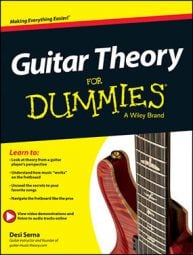On the guitar you can use the notes along strings 6 and 5 to track any note on the fretboard with the help of octave shapes. An octave is the distance between one pitch and another with half or double its frequency. In other words, it’s a higher or lower version of the same pitch.
You can also think of an octave as the same pitch in a different register. Octave pitches are also called unison pitches. On the guitar fretboard, octaves follow certain spacings or shapes that you finger in different ways.
In music, the word unison can mean a couple of things. Firstly, it refers to two identical pitches being sounded by separate or different instruments, including voices. For example, two guitar players both playing their 6th strings open produce unison pitches.
Secondly, it can refer to pitches that are the same but separated by an octave or more. For example, one guitarist playing the 6th string open and another playing the 1st string open, both E, produce unison pitches.
How to shape octaves with your 1st finger on strings 6 and 5
The first octave shape you need to know stems off of strings 6 and 5. Place your 1st finger somewhere on the 6th or 5th string and use another finger to reach over two strings and up two frets. You now have the same note an octave higher. Notice that you can also play octaves of the open strings.
![[Credit: Illustration courtesy of Desi Serna]](https://www.dummies.com/wp-content/uploads/419030.image0.jpg)
You can finger these octave shapes with either your 1st and 3rd fingers or your 1st and 4th fingers — whichever is more comfortable. You also have the option of picking the strings separately, fingerpicking them together, or muting the unwanted strings as you strum.
Guitar players usually opt to strum octave shapes on strings 6 and 5 by using a pick and leaning their fretting fingers back to touch (but not fret) other strings to prevent them from ringing. This technique creates a raking sound from the muted strings.
Jazz guitar legend Wes Montgomery was famous for playing melodies and solos by using octave shapes, opting to strum across the strings with the pad of his right thumb for a soft, mellow sound. You hear this technique in his song “Bumpin’ on Sunset.” Jimi Hendrix strummed the same kind of octave shapes with a pick, using distortion, for his songs “Fire” and “Third Stone from the Sun.”
There is a demonstration at Chapter 2, Video Clip 1: Octaves on Strings Six and Five.
If you need to identify a note on string 4 or 3, use octave shapes to trace it back to the notes you have memorized on strings 6 and 5.
How to shape octaves with your 1st finger on strings 4 and 3
You can play octave shapes with your 1st finger on string 4 or 3 and the octaves on string 2 or 1, although the shapes are slightly different than they are on strings 6 and 5. With the way the 2nd string is tuned (one half step lower), you need to move over two strings and up three frets to reach the octave.
![[Credit: Illustration courtesy of Desi Serna]](https://www.dummies.com/wp-content/uploads/419031.image1.jpg)
Remember that you can also play octaves of the open strings.
If you have to identify a note on string 2 or 1, use octave shapes to trace it back to strings 4 and 3 and then again to strings 6 and 5. However, keep in mind that the 1st string is E just as the 6th string is E, and the positions of all the notes on both strings are the same.
How to shape octaves that are three strings apart
Another octave shape that’s less common but still good to know reaches over three strings and in the direction opposite the previous shapes direction. You can play these octaves by placing your 1st finger on either string 1 or 2 and then reaching over to either string 4 or 5 with either your 3rd or 4th finger.
![[Credit: Illustration courtesy of Desi Serna]](https://www.dummies.com/wp-content/uploads/419032.image2.jpg)
Octaves beyond the 12th fret
Fortunately for your memory, everything — including notes and spacing — repeats at the 12th fret. Hence, all the inlay markers beyond the 12th fret correspond to the inlays before the 12th fret, which is why most guitars specially mark the 12th fret with two inlays.
Just as strings 6 and 5 open are E and A, the same strings are E and A at the 12th fret. Just as the first inlay marker past the open 6th string is G, the first marker past the 12th fret is also G. On the 5th string, C is at the first markers in both positions.
![[Credit: Illustration courtesy of Desi Serna]](https://www.dummies.com/wp-content/uploads/419033.image3.jpg)
The guitar neck between 0 and 12 is identical to the neck between 12 and 24, though your guitar may not have a full 24 frets. Notice the fret numbers indicated below the neck diagrams.

